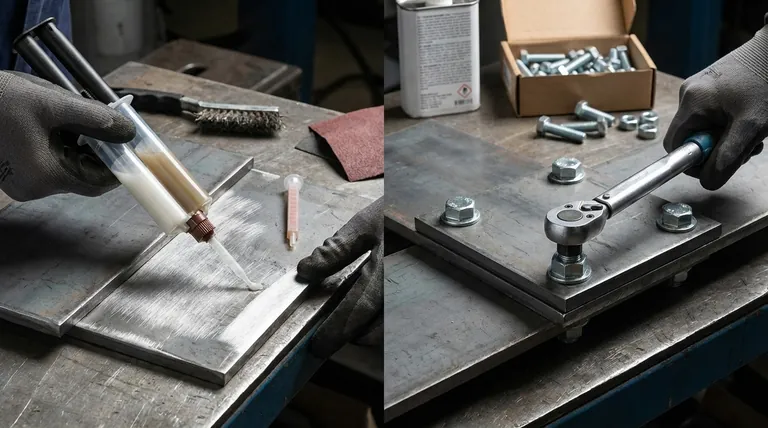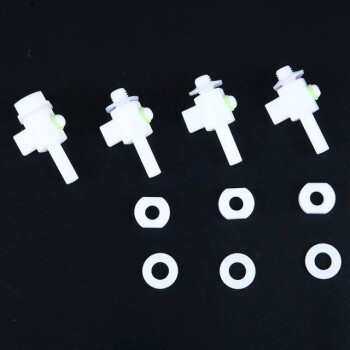To bond steel to steel without welding, you have two primary methods: using high-strength structural adhesives or employing mechanical fasteners. Structural adhesives, such as two-part epoxies and polyurethanes, create a chemical bond across the entire joined surface, while mechanical fasteners, like bolts and rivets, physically clamp the pieces of steel together at specific points.
The core decision is not simply about replacing a weld, but about choosing a completely different joining philosophy. While welding creates a single, monolithic piece of metal, adhesives and fasteners create an assembly, each with distinct advantages and crucial trade-offs regarding strength, environment, and application.

The Primary Alternative: Structural Adhesives
Modern structural adhesives are engineered to create bonds that can meet or even exceed the strength of the base metal in certain load conditions. They work by chemically curing to form a rigid, durable connection.
What Are Structural Adhesives?
These are not common glues; they are reactive chemical systems, often supplied in two parts (a resin and a hardener), that undergo a chemical reaction when mixed. This reaction forms an incredibly strong and permanent bond that distributes stress evenly across the entire bonded area, unlike the concentrated stress points of a weld or bolt.
Key Adhesive Types for Steel
- Epoxies: These are the gold standard for high-strength, rigid bonding. Two-part epoxies offer exceptional resistance to heat, chemicals, and water. They are ideal for static applications where the joint will not be subject to significant flexing or impact.
- Polyurethanes: While still very strong, polyurethanes offer significantly more flexibility and impact resistance than epoxies. This makes them a better choice for joints that will experience dynamic loads, vibration, or thermal expansion and contraction.
- Methyl Methacrylates (MMAs): These acrylic adhesives are known for their fast cure times and ability to bond well to a variety of surfaces with less intensive preparation. They combine high strength with good flexibility, making them a versatile option.
The Critical Role of Surface Preparation
The success or failure of an adhesive bond depends almost entirely on surface preparation. The steel surfaces must be immaculately clean, free of oil, grease, rust, and scale. For maximum strength, the surface should also be abraded (e.g., via sandblasting or sanding) to create a rough texture, which gives the adhesive a greater surface area to "key" into mechanically.
The Traditional Method: Mechanical Fasteners
Mechanical fastening is the oldest and most straightforward method for joining steel. It relies on the physical strength of the fastener and the clamping force it generates.
Understanding Fastening Principles
Unlike adhesives that bond surfaces, fasteners join materials by creating a point of connection through them. The strength of the joint is concentrated at the location of each fastener. This method is highly predictable and governed by well-understood engineering principles.
Common Fastener Types for Steel
- Bolting: Bolts, nuts, and washers are the most common method, primarily because they allow for disassembly. The strength is determined by the bolt's material grade, diameter, and the torque applied during tightening, which creates a powerful clamping force.
- Riveting: Rivets are permanent fasteners used in high-stress, high-vibration environments like bridges and aircraft frames. A heated or cold rivet is passed through holes in the steel plates and then deformed, creating a head that permanently clamps the pieces together.
Understanding the Trade-offs
Choosing a non-welding method requires a clear understanding of what you gain and what you sacrifice compared to welding and to each other.
Strength and Load Distribution
Welding effectively fuses the steel, making the joint as strong as the parent metal. Adhesives spread the load over a large surface, making them exceptionally strong in shear (sliding forces) but weaker in peel or cleavage (pulling-apart forces). Fasteners create high-strength points but can also be stress concentrators if not designed correctly.
Environmental Sealing and Corrosion
An adhesive bond creates a continuous, gap-free seal between the two steel surfaces. This barrier prevents moisture ingress and can completely stop crevice corrosion between the parts. In contrast, drilling holes for fasteners creates new potential sites for rust to begin.
Aesthetics and Design Freedom
Adhesives are applied between the surfaces, making the bond completely invisible. This allows for clean, smooth exterior surfaces that are impossible to achieve with visible bolt heads or weld beads.
Application Process and Skill
Adhesives require meticulous cleaning, precise mixing, and a designated cure time where the part must remain undisturbed. Fastening requires accurate drilling and proper torque specifications. Both require attention to detail, but the skill sets are very different from the specialized training required for welding.
Making the Right Choice for Your Application
The best method is the one that aligns with your project's non-negotiable requirements. Evaluate your priorities to make a clear decision.
- If your primary focus is maximum structural strength and permanence: Welding remains the benchmark, but high-strength epoxies are a viable alternative for distributing large shear loads.
- If your primary focus is disassembly or future maintenance: Bolted mechanical fasteners are the only practical choice.
- If your primary focus is a clean aesthetic and environmental sealing: Structural adhesives are the superior option, provided the joint is designed to be loaded in shear.
- If your primary focus is resistance to vibration and fatigue: Riveting is a proven solution, and flexible adhesives like polyurethanes can also absorb energy and perform extremely well.
By understanding these core principles, you can confidently select a bonding method that ensures the safety, durability, and performance of your project.
Summary Table:
| Method | Key Feature | Best For |
|---|---|---|
| Structural Adhesives | Continuous chemical bond across entire surface | Clean aesthetics, sealing against corrosion, even stress distribution |
| Mechanical Fasteners | Physical clamping at specific points | Disassembly, high-vibration environments, proven engineering principles |
Ready to select the right bonding method for your steel project? The choice between adhesives and fasteners is critical for your project's safety and performance. KINTEK specializes in providing the high-quality lab equipment and consumables necessary for precise surface preparation and testing of bonded joints. Our expertise supports industries that rely on strong, durable steel assemblies. Contact our experts today to discuss your specific application and ensure a successful, long-lasting bond.
Visual Guide

Related Products
- High Purity Zinc Foil for Battery Lab Applications
- High-Purity Titanium Foil and Sheet for Industrial Applications
- Vacuum Cold Trap Chiller Indirect Cold Trap Chiller
- CF KF Flange Vacuum Electrode Feedthrough Lead Sealing Assembly for Vacuum Systems
- Custom-Made Alumina Zirconia Special-Shaped Ceramic Plates for Engineering Advanced Fine Ceramics Processing
People Also Ask
- What are the barriers to plastic recycling? The Economic, Material, and Technical Hurdles Explained
- What are the three types of coating? A Guide to Architectural, Industrial, and Special Purpose
- What are two disadvantages of metal? Understanding Corrosion and Weight Limitations
- What is the difference between metallic and non-metallic coating? A Guide to Sacrificial vs. Barrier Protection
- What are the advantages disadvantages and uses of sheet metal? The Ultimate Guide to Material Selection



















